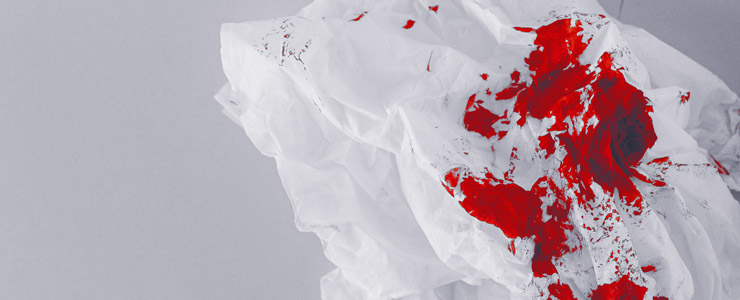
Nasal bleeding is a common affliction. At times, it may be a symptom of a disease. Bleeding from the nose is manifested by blood leaking from the vascular system.
The nose is made up of muscle, cartilage and skin parts. In addition, it is divided into two nasal cavities, in which there is a mucous membrane performing its own functions. The temperature of the air entering the nose can reach up to 32-34 degrees, as the nose is much vascularised. The blood that circulates through the dilated blood vessels in the nose acts as a kind of a radiator. The air entering the nasal cavity is also cleaned, as any impurities that settle down at the entrance of the nose are moved towards the throat, thanks to cilia and saliva.
There can be various causes for nosebleed:
![]() Hypertension
Hypertension
![]() Infectious diseases with fever
Infectious diseases with fever
![]() Congenital hemorrhagic blemishes (haemophilia and related diseases, thrombocytopenia) or acquired ones (liver damage, acquired thrombocytopenia)
Congenital hemorrhagic blemishes (haemophilia and related diseases, thrombocytopenia) or acquired ones (liver damage, acquired thrombocytopenia)
![]() Deformation of the nasal septum, a nasal injury
Deformation of the nasal septum, a nasal injury
![]() Excessive exposure to sunlight or overheating of the body
Excessive exposure to sunlight or overheating of the body
![]() Physical effort
Physical effort
![]() Atherosclerosis
Atherosclerosis
![]() Other conditions (e.g. Cancer, mucous membrane inflammation, foreign bodies, etc.)
Other conditions (e.g. Cancer, mucous membrane inflammation, foreign bodies, etc.)
![]() Nasal vascularity, which begins in the internal and external carotid arteries
Nasal vascularity, which begins in the internal and external carotid arteries
The procedure in the case of nosebleed is as follows:
![]() Make sure the person sits down with their head slightly tilted forward
Make sure the person sits down with their head slightly tilted forward
![]() The person should breathe with their mouth
The person should breathe with their mouth
![]() Put a cold compress on their neck and forehead, such as a towel soaked in cold water or wrapped around ice cubes
Put a cold compress on their neck and forehead, such as a towel soaked in cold water or wrapped around ice cubes
![]() Put gauze or a handkerchief on their nose, squeeze the bleeding nostril and keep it tight for about 10 minutes
Put gauze or a handkerchief on their nose, squeeze the bleeding nostril and keep it tight for about 10 minutes
![]() If the nasal bleeding is severe and persists after these operations have been performed (more than 15 – 20 minutes) or if there has been an injury of the head or the neck, or a disturbance in consciousness, call an ambulance
If the nasal bleeding is severe and persists after these operations have been performed (more than 15 – 20 minutes) or if there has been an injury of the head or the neck, or a disturbance in consciousness, call an ambulance
How to prevent nasal haemorrhages?
![]() Keep the nasal mucosa moistened (particularly during autumn and winter). Air humidifiers can be used for this purpose
Keep the nasal mucosa moistened (particularly during autumn and winter). Air humidifiers can be used for this purpose
![]() Avoid nose picking, which can lead to micro trauma and bleeding
Avoid nose picking, which can lead to micro trauma and bleeding
![]() If the person is using mucosal constrictors, it is necessary to remember that it is not advised to use this type of medicine for more than 5 days, as they may interfere with the proper flow and air purification in the nose and damage the mucosa. It is safer to use an isotonic solution of sea water, which gently moisturizes the mucous membranes and can be used for extended periods of time
If the person is using mucosal constrictors, it is necessary to remember that it is not advised to use this type of medicine for more than 5 days, as they may interfere with the proper flow and air purification in the nose and damage the mucosa. It is safer to use an isotonic solution of sea water, which gently moisturizes the mucous membranes and can be used for extended periods of time
![]() All cases of nosebleed (especially the intense ones) should be consulted with a doctor
All cases of nosebleed (especially the intense ones) should be consulted with a doctor
![]() Record the pressure measurements if the person has problems with hypertension, as the risk of nosebleed is increased
Record the pressure measurements if the person has problems with hypertension, as the risk of nosebleed is increased
Back Next
![]()
First Aid for the Elderly in Emergency:77% complete
